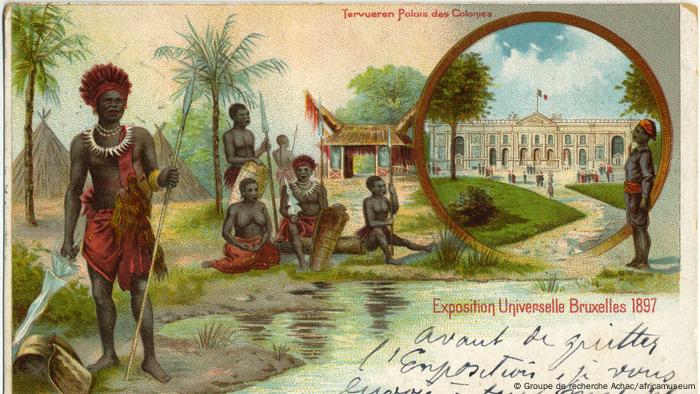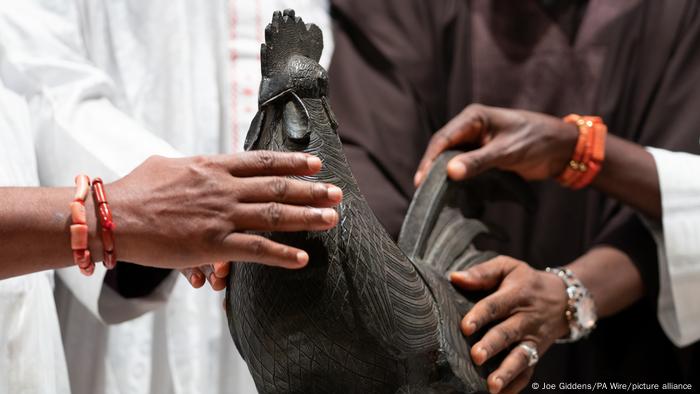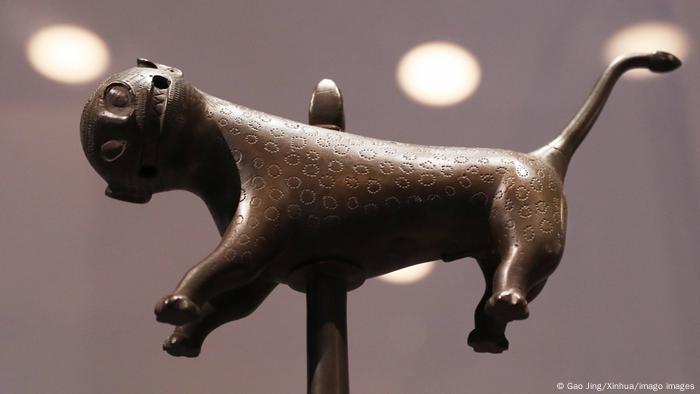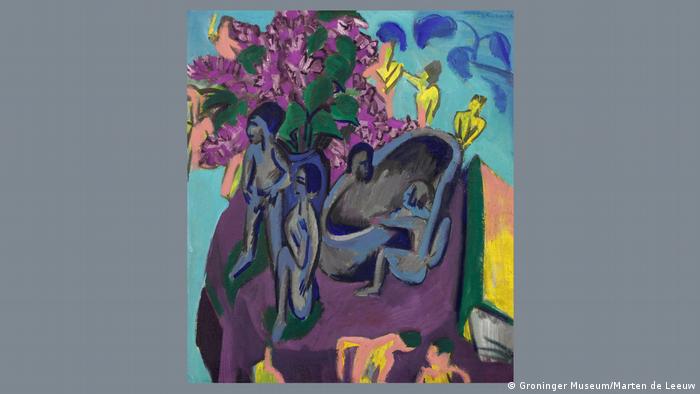After their request to borrow a sculpture created by their ancestors was denied, a Congo-based artist collective found a different way to repatriate it.

A Belgian colonial postcard from 1897, the year the Royal Museum for Central Africa opened in Brussels
Somewhere in a decentralized, virtual realm lives a newly minted non-fungible token (NFT), a unique digital asset that can be sold or traded using cryptocurrency.
It features a virtual rendering of a sculpture crafted in 1931 by Congo’s Pende people. Suspended somewhere between fantasy and reality, the image rotates counterclockwise against a black background, revealing a new dimension with every turn.
In the physical world, the deeply spiritual sculpture has been out of its source community’s reach for years — and still is.
History of rebellion
The physical sculpture is made of wood, rather than the bits of 1s and 0s analyzed by computers to generate images. It represents a history of rebellion for the Pende people, according to Renzo Martens, a Danish curator who helped create the NFT.
The project was led by the Congolese Plantation Workers Art League (CATPC), an artist collective that lives and works on a plantation owned by the 400-brand multinational consumer goods company Unilever in Lusanga, Congo.
Featuring meticulously carved downcast eyes and a rigid stance, the statue depicts Maximilien Balot, a Belgian colonial agent sent to brutally conscript members of the Pende community to work as unpaid laborers at a subsidiary owned by modern day Unilever.
Watch video 03:04 Colonial Belgium abducted children with African mothers
Balot was slain in a fight with a Pende man in 1931. After his death, the Pende people created the sculpture to capture and control his spirit as an aid in their fight against Belgian colonial rule.
Although Balot’s visage was wrought from biodegradable material that should have deteriorated over time, it has been preserved in the physical realm.
The sculpture first changed hands in 1972, when it was purchased for around €109 ($120) by tribal arts collector and City University of New York professor Herbert Weiss on a trip to Congo. Weiss later sold it to the Virginia Museum of Fine Arts (VMFA), where it is still on display today.
Tech inspiration
The idea to turn the statue into an NFT emerged in 2020 after an unsuccessful attempt by artists Mathieu Kasiama and Cedart Tamasala to formally loan it.
The process was recorded in a documentary called Plantations and Museums, which tracked the CAPTC's attempt to repossess the Balot sculpture to display temporarily at the White Cube, a community art gallery on the plantation.
In Plantations and Museums, when the artists explained their desire to borrow the statue for temporary display to the VMFA's head curator, they were met with ambivalence.
"You've raised a very interesting suggestion," the curator answered.
A year and a half later, the VMFA sent the collective a letter formally denying their request.
Martens told DW the VMCA said the White Cube was not suited to display the piece and gave no answer as to whether the sculpture would be available in the future.
The VMFA did not respond to DW's phone calls for comment.
Making an NFT
The pathway to NFT-fueled repatriation moved much faster than the team’s back and forth with the museum.
Making an NFT can be as easy as drawing a photo on a sketch app, or as hard as layering 10 separately drawn digital images.
The true beauty of an NFT is in its code, which is unique and cannot be faked or copied.
To get this individual string of data, an NFT must be converted into a digital asset stored on the blockchain, a system that records transitions across several computers.

A Benin Bronze statue is returned to Nigeria at a 2021 ceremony at Jesus College in Cambridge
The CAPTC deployed the help of a photographer, who shot original photos of the sculpture, and a group of Berlin-based artists, who arranged them, to create the Balot NFT.
Just an image
The digital repatriation was completed without permission from the VMFA.
The museum criticized the group’s creative rendering of the piece, calling it "unacceptable and unprofessional" and claiming that “its use for financial gain” violated the museum's open-access polic
Watch video 04:33 NFT Fraud and Counterfeiting
But Marten says it's all fair use.
"The only thing we took from the museum by making this NFT is its images and photographs — it's simply an image of sculpture," he said.
'A tool for decolonization'
Each time an NFT is created or exchanged, it is recorded on an unalterable ledger via the blockchain.
So, when an artist mints an NFT, they permanently enmesh themselves in the digital chain of creation. Their role in its construction cannot be erased. In this way, an NFT can become "a tool for decolonialization," said Martens.
According to Tochukwu Macfoy, who directs content for Design Week Lagos, an annual Lagos-wide exhibition for creators, NFT-initiated repatriation can be "a chance to own all the conversation."

This artifact, previously housed in France, will be returned to Nigeria.
In January, a group of artists launched the Benin Bronze NFT Cultural Exchange Project. Although the physical group of plaques, heads and sculptures looted from the Kingdom of Benin (modern Nigeria) by the British Royal Army in 1897 now rest in museums and private collections throughout the world, the group of creators hoped their project would bring awareness to their absence in Nigeria.
In early March, the Smithsonian Institution announced that it would return most of its Benin Bronze collection to Nigeria.
Despite the criticism that the CAPTC received from the VMFA for their first digital repatriation, the collective has not been discouraged.
"Art was created as a way of fighting the plantation system," Kiasama said in Plantations and Museums.
Martens says that they plan to mint more NFTs of the community’s artifacts in the future. The proceeds from these digital sales will be used to fund purchases of real-world plantation land where the CAPTC and other members of the community still live and work.

GERMAN EXPRESSIONISTS AND COLONIALISM
The primitivist art movement
Bright, contrasting colors, simplified forms, and a return to a supposedly simple life untouched by industrialization are among the features of primitivism. Ernst Ludwig Kirchner's "Still Life with Flowers and Sculptures" (1912) is a primary example. In Germany, this style was at the height of popularity when imperial Germany was a colonial power.
12345678
Edited by: Clare Roth
AUDIOS AND VIDEOS ON THE TOPIC
What dangers are hidden within the crypto-art craze?
Benin welcomes back looted artifacts
No comments:
Post a Comment